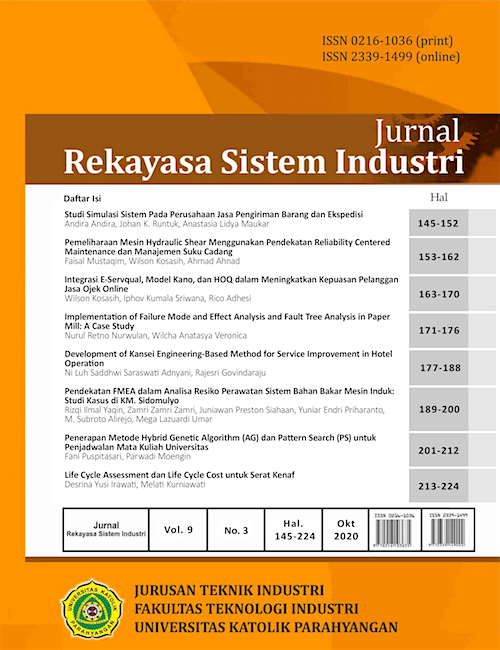Studi Simulasi Sistem Pada Perusahaan Jasa Pengiriman Barang dan Ekspedisi
DOI:
https://doi.org/10.26593/jrsi.v9i3.3769.145-152Abstract
Currently, the competition of delivery service providers is increasing. Companies must strive to improve customer service and satisfaction to survive in this competition. One of the service improvements relates to the queuing system. This research was conducted at the counter of a logistics company, which provides delivery and expedition services, located in Cikarang, Bekasi. There was often a build-up of queues at counters and accumulated goods to be packaged. As a result, officers have very high utilization, because they should serve the customers; meanwhile, they also have to do packing works. This study uses a simulation approach to analyse and improve the performance of the current queuing system. Simulations are carried out using Promodel in the delivery handling system, namely starting when the customer enters the store, handling customer needs (including in the case of packing the goods until the service is complete and the customer leaves the store. There are two suggestions for improvement; short-term and medium-term improvement proposals for the short-term focus on customer service (excluding packaging), namely by providing registration forms and also preparing a refund that can shorten the service process. Meanwhile, the long-term improvement is to strengthen the service system with an additional information system, standardization of processes and costs, as well as extra officers who specialize in packing. The simulation results show that short and medium-term improvement can reduce waiting time and utilization, and increase the number of goods packed.
References
Arwindy, F., Buulolo, F., & Rosmaini, E. (2014). Analisis dan Simulasi Sistem Antrean pada Bank ABC. Saintia Matematika, 2(2), 147–162.
Banks, J., Carson II, J.S., Nelson, B.L., & Nicol, D.M. (2004). Discrete-Event System Simulation (4th ed.). Prentice Hall.
Blanchard, B.S. (1991). System Engineering Management. New York: John Wiley & Sons.
Davis, F. W., & Manrodt, K. B. (1997). Logistics : An Introduction. International Journal of Physical Distribution &Logistics Management, 21(7), 4–13.
Dominic, C. (2010). Packaging Logistics Performance. Thesis for the Degree of Doctor of Philosophy. Department of Design Sciences Division of Packaging Logistics Lund University.
Harrell, C., Ghosh, B. K., & Bowden, R. (2000). Simulation Using Promodel. United States of America: McGraw-Hill Companies, Inc.
Heizer, J., & Render, B., (2013).Operations Management: Sustainability and Supply Chain Management, (11th ed). Pearson Education.
Hoover, S.V., & Perry, R. F. (1989). Simulation A Problem–Solving Approach. Digital Equipment Corporation & Northeastern University.
Law, A. M., & Kelton, W. D. (1991). Simulation Modeling & Analysis, (2nd ed.). New York: McGraw-Hill; International.
Schmidt, A. K. R. (1988). Simulation of Logistic System. Logistics World, 1(1), 47–52.
Thiers, G., & McGinnis, L. (2011). Logistics Systems Modeling and Simulation. Proceedings - Winter Simulation Conference, 1531–1541.

